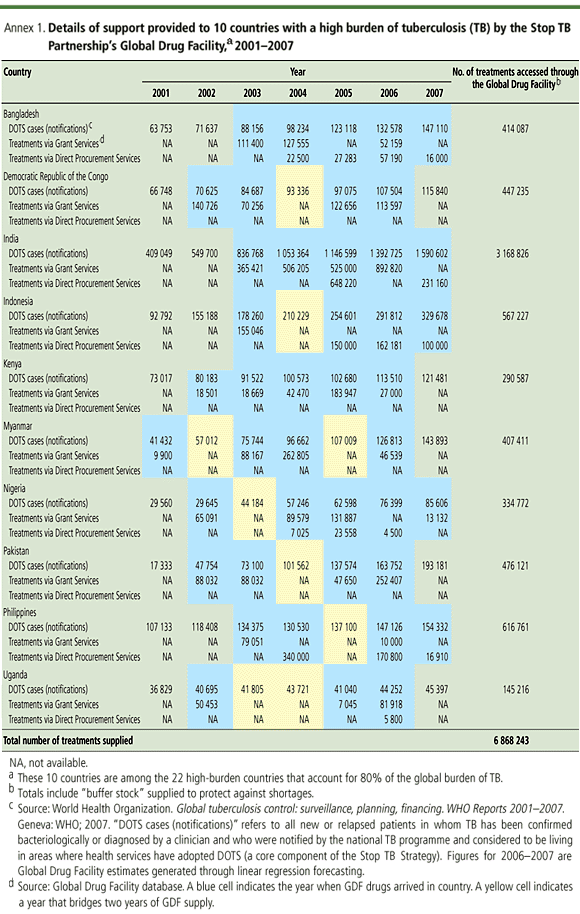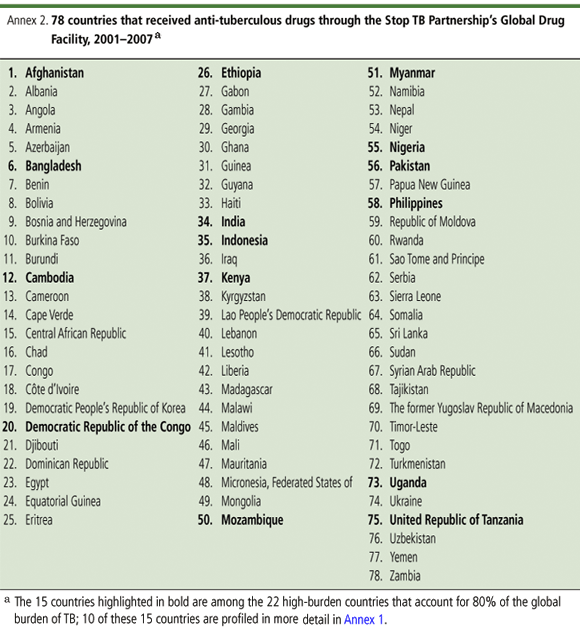POLICY AND PRACTICE
The Global Drug Facility: a unique, holistic and pioneering approach to drug procurement and management
Le dispositif mondial dapprovisionnement en médicaments antituberculeux : une approche unique, globale et novatrice pour lacquisition et la gestion de médicaments
El Servicio Farmacéutico Mundial, un mecanismo singular, holístico e innovador para la adquisición y gestión de medicamentos
Robert Matiru1; Timothy Ryan
Stop TB Global Drug Facility, WHO, 20 avenue Appia, 1211 Geneva 27, Switzerland
ABSTRACT
In January 2006, the Stop TB Partnership launched the Global Plan to Stop TB 20062015, which describes the actions and resources needed to reduce tuberculosis (TB) incidence, prevalence and deaths. A fundamental aim of the Global Plan is to expand equitable access to affordable high-quality anti-tuberculous drugs and diagnostics. A principal tool developed by the Stop TB Partnership to achieve this is the Global Drug Facility (GDF).
This paper demonstrates the GDFs unique, holistic and pioneering approach to drug procurement and management by analysing its key achievements. One of these has been to provide 9 million patient-treatments to 78 countries in its first 6 years of operation. The GDF recognized that the incentives provided by free or affordable anti-tuberculosis drugs are not sufficient to induce governments to improve their programmes standards and coverage, nor does the provision of free or affordable drugs guarantee that there is broad access to, and use of, drug treatment in cases where procurement systems are weak, regulatory hurdles exist or there are unreliable distribution and storage systems. Thus, the paper also illustrates how the GDF has contributed towards making sustained improvements in the capacity of countries worldwide to properly manage their anti-TB drugs. This paper also assesses some of the limitations, shortcomings and risks associated with the model. The paper concludes by examining the GDFs key plans and strategies for the future, and the challenges associated with implementation.
RÉSUMÉ
En janvier 2006, le Partenariat Halte à la tuberculose a lancé le Plan mondial Halte à la tuberculose 2006-2015, qui expose les interventions et les ressources nécessaires pour réduire lincidence et la prévalence de la tuberculose (TB), ainsi que le nombre de décès qui lui sont imputables. Lun des objectifs fondamentaux de ce plan mondial est délargir laccès équitable à des médicaments antituberculeux et à des outils diagnostics peu onéreux. Pour parvenir à cette fin, le Partenariat a mis au point un outil essentiel : le dispositif mondial dapprovisionnement en médicaments antituberculeux (GDF).
Le présent article met en lumière la nature unique, globale et innovante de cette approche pour lacquisition et la gestion de médicaments en analysant ses principales réalisations. Lune delles a consisté à fournir 9 millions de patients-traitement à 78 pays au cours de ses 6 premières années de fonctionnement. Le GDF a reconnu que la fourniture de médicaments antituberculeux gratuits ou à un prix abordable ne suffisait ni à amener les Gouvernements à améliorer la qualité et les taux de couverture de leurs programmes, ni à garantir un accès étendu et une large utilisation de ces médicaments en présence de systèmes dapprovisionnement des médicaments peu performants, dobstacles réglementaires ou de systèmes de distribution et de stockage non fiables. Cet article montre également ainsi comment le GDF a contribué à lamélioration durable des capacités de pays du monde entier à gérer correctement leurs antituberculeux. Il évalue également certaines des limites, des insuffisances et des risques associés à ce modèle. Il conclut par une analyse des stratégies et des plans principaux du GDF pour lavenir, ainsi que des difficultés que rencontrera leur mise en uvre.
RESUMEN
En enero de 2006, la Alianza Alto a la Tuberculosis lanzó el Plan Mundial para Detener la Tuberculosis 2006-2015, en el que se describen las iniciativas y los recursos necesarios para reducir la incidencia y prevalencia de tuberculosis y la mortalidad por esa causa. Un objetivo fundamental del Plan Mundial es expandir el acceso equitativo a medicamentos y medios diagnósticos antituberculosos asequibles de calidad, y un instrumento primordial desarrollado por la Alianza Alto a la Tuberculosis con ese fin es el Servicio Farmacéutico Mundial (GDF).
Este artículo muestra el enfoque singular, holístico e innovador aplicado por GDF a la adquisición y gestión de los medicamentos, analizando los principales logros del sistema. Uno de ellos ha sido el de proporcionar 9 millones de tratamientos-paciente a 78 países en sus seis primeros años de funcionamiento. GDF reconoció que los incentivos en forma de medicamentos antituberculosos gratuitos o asequibles no son suficientes para inducir a los gobiernos a mejorar el nivel y la cobertura de sus programas, ni tampoco para garantizar un amplio acceso al tratamiento farmacológico, y una amplia utilización del mismo, en los casos de precariedad de los sistemas de adquisición, existencia de trabas normativas o escasa fiabilidad de los sistemas de distribución y almacenamiento. Así, en el artículo se muestra también cómo ha contribuido GDF al logro de mejoras sostenidas de la capacidad de muchos países para gestionar adecuadamente sus medicamentos antituberculosos. Se evalúan asimismo algunas de las limitaciones, las deficiencias y los riesgos asociados al modelo. El artículo concluye con un examen de los principales planes y estrategias de GDF con miras al futuro y de los retos que conlleva su implementación.
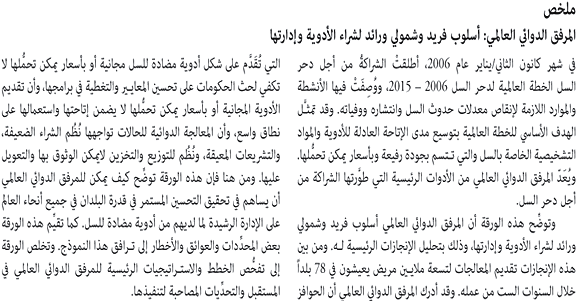
Introduction
The Global Drug Facility (GDF) for tuberculosis (TB) was launched on World TB Day 2001; it grew out of a declaration made a year earlier by countries attending the Ministerial Conference on TB and Sustainable Development in Amsterdam. Members of the conference indicated that they desired to "build new international approaches towards ensuring universal access to, and efficient national systems of procurement and distribution of anti-TB drugs".1 The Global Drug Facility is housed and administered by WHO within the Stop TB Partnership secretariat. It was established with a mandate to:
-
ensure uninterrupted access by national TB control programmes to high-quality anti-TB drugs for implementation of the DOTS2 treatment strategy (DOTS is a core component of the Stop TB Strategy and WHOs recommended strategy for controlling TB);
-
catalyse rapid expansion of the DOTS strategy to achieve WHOs global targets for TB control;
-
stimulate political and public support in countries worldwide for public funding of anti-TB drug supplies; and
-
secure sustainable global control and eventual elimination of the disease.
The GDF is fulfilling its mandate by using a bundled model comprising three services, each tailored to the needs of national TB control programmes in gaining access to anti-TB drugs (Table 1). The model is unique and innovative, setting the GDF apart from traditional procurement mechanisms, as it:
-
links demand to supply and post-delivery monitoring and evaluation;
-
ensures that any grants made by the GDF are given in addition to already existing resources;
-
outsources competitively all services to collaborative and contractual partners who have demonstrated a technical and/or financial advantage in a specific competency;
-
uses product standardization and packaging to simplify drug management;
-
links grants to the performance of anti-TB programmes; and
-
combines international public sector policy and practice with cutting-edge private-sector technologies and operating procedures to ensure efficiency.

Achievements
Impact of grants and procurement services
Patients treatments
Through its Grant Services and Direct Procurement Services, the GDF has provided 9 million life-saving anti-TB drug treatments in 78 countries (Annex 1 and Annex 2, available at http://www.who.int/bulletin). The GDFs anti-TB drug supplies reach approximately 20% of the estimated 8.8 million TB patients worldwide in 15 of the 22 countries considered to have a high burden of TB; these countries account for 80% of the global TB burden. The cumulative number of treatments supplied to cover the shortfalls in drug supply in national TB programmes is large. The GDF plans to go further, however, and measure the extent of its success in supplying treatments. After six years of operation, the GDFs impact can be assessed in terms of the number of patients treated or cured and how much progress has been made towards the global targets for TB control set by the World Health Assembly in 1991. Implementing this type of impact assessment will be crucial in providing the epidemiological evidence necessary to confirm that the GDF is one of the most cost-effective and efficient channels for helping to control TB.
DOTS expansion
The GDFs catalytic role in expanding the DOTS strategy has been documented in an earlier publication.3 Nonetheless, it is important to emphasize that challenges to DOTS implementation in different regions and countries have meant that the GDF has had a variable impact overall (Table 2).
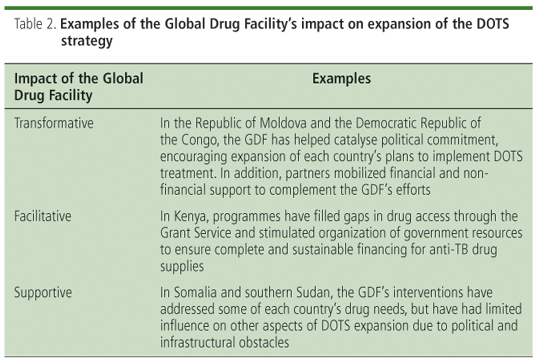
Competition and cost-effectiveness
After its launch, GDF has secured competitive prices for high-quality anti-TB drugs through the use of international tendering mechanisms, pooled demand and systematized forecasting. The GDFs prices for anti-TB drugs were, on average, one-third less than previous international tenders.4 The GDF is able to offer a six-month course of treatment for a newly diagnosed smear-positive patient for approximately US$ 20; thus the GDF remains competitive. Moreover, by publishing its prices in the public domain, the GDF builds transparency and global awareness of the pricing of anti-TB drugs.
However, the GDFs yardstick for competitiveness does not measure only price: the efficiency and effectiveness of services delivered to countries is paramount. The GDF relies on a lean operational team and many functions are outsourced to agents. During the past five years, the GDFs operational turnover consistently has seen more than 80% of funds from donors spent on drugs and related costs, and less than 5% on staffing. Table 3 (available at http://www.who.int/bulletin) illustrates the confidence that donors have regarding the GDF providing value for money.

The GDF does not sacrifice quality for efficiency; it uses an internal quality management system that complies with standards set by the International Organization for Standardization for the "provision of quality-assured anti-TB drugs and related services to eligible national TB control programmes".5 State-of-the-art information systems are used to maintain strict controls and monitor work. The GDF regularly reports on key indicators of performance and impact through its public web site (http://www.stoptb.org/gdf) and annual reports.
Equity of access
The GDF has promoted access to treatment for underprivileged communities by restricting its grants to countries where the annual per capita gross national income (GNI) is < US$ 3000 (and priority is given to countries with a per capita GNI < US$ 1000). The GDF also requires that all drugs it supplies are provided free of charge to ensure that poor patients have access to treatment. This approach is inherently equitable, since countries of all sizes that use the Direct Procurement Service benefit from the same prices and range of services.
A model for other diseases
The GDF has developed a model that has proven to be replicable for other diseases. The model has been emulated by the International Union Against Tuberculosis and Lung Disease in its Asthma Drug Facility (http://www.globaladf.org). The interim secretariat of the Global Fund to Fight AIDS, Tuberculosis and Malaria (the Global Fund, http://www.theglobalfund.org/) borrowed key elements from the GDF and the Stop TB Partnership to inform its initial and current structure; some of these elements are found in its Technical Review Panel and Board. In September 2006, UNITAID (http://www.unitaid.eu) was established as an international drug-purchasing facility with a mandate to accelerate access to high-quality drugs and diagnostics for patients with HIV/AIDS, malaria and TB in countries that have a high burden of these diseases; key elements of the GDFs and the Stop TB Partnerships models were adopted to frame its interim operations and inform its set-up. Other important achievements, such as standardization of product supply and simplification of drug management, have been reported by different authors6 and are not covered here.
Having outlined the key achievements of the GDFs Grant Services and Direct Procurement Services, it is important to highlight some of their drawbacks. One fundamental disadvantage of offering grants for free drugs to countries is that it is an unsustainable mechanism and does not promote long-term self-sufficiency within a country. The GDF is aware of the dangers of creating dependency. From the outset the GDF was envisioned as a time-limited programme, and the terms and conditions of its grants to countries require that the GDFs drugs are used in addition to existing budgets or mandates for TB control.7 In most of the countries supported by the GDF this conditionality has worked, with budget lines either maintained or (in some cases) increased, as assessed through regular monitoring of programme financing.8
Yet many countries have not created a specific budget line for anti-TB drugs, or have failed to spend budgeted monies. Despite the GDFs strict requirements, in some cases budget lines for anti-TB drugs have been reduced or substituted (Table 4, available at http://www.who.int/bulletin). The GDF routinely encourages grant recipients to use the procurement service as a cost-sharing exercise, typically with part of their needs covered by the GDFs in-kind donations and the remainder financed by the countries themselves. A key limitation of the procurement service, however, is that many of the countries that buy anti-TB drugs through the GDF do so by engaging in donor substitution that is, transitioning from the GDFs grant to a new donors funds, rather than by establishing and using more sustainable national resources.
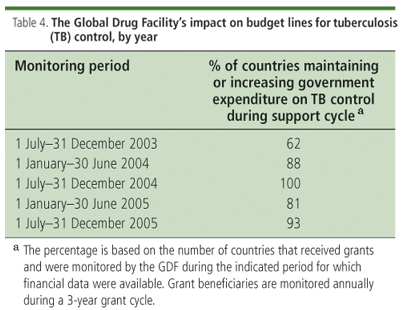
Technical support service: strengthening health-system capacity and drug quality
Building capacity to manage drug supplies
Shortages of anti-TB drugs frequently result from insufficient capacities within a country to plan, fund, procure or manage its drug supply. The GDF has successfully used a holistic approach to address immediate gaps in drug supply, while helping countries to overcome systemic problems and establish the long-term drug-management capacity needed by national TB control programmes.
Since 2001, the GDF has sent more than 200 teams of drug management and TB experts to various countries. Mission teams monitor the use of existing drug supplies while working with national programmes to address bottlenecks and weaknesses in their supply chains and help programmes plan for their future drug needs. The GDF also organizes workshops to provide training for national programme staff involved in the procurement and management of anti-TB drugs. Workshops on pharmaceutical management provide in-country staff with basic skills that may also help them better manage medicines and supplies for other disease-control programmes (such as HIV/AIDS and malaria). Additionally, the workshops also focus on training national stakeholders to prepare procurement plans for submission to international financing mechanisms, such as the Global Fund.
Strengthening quality assurance
Technical support offered by the GDF extends to strengthening the quality assurance process for anti-TB drugs. From 2002 to 2006, the GDF provided funding and technical input to WHOs prequalification programme for anti-TB drugs. The GDF requires that all the anti-TB drugs that it supplies either be prequalified under the WHO programme or approved for supply through a transparent, independent expert committee convened by WHO pending prequalification. All batches of drugs supplied by the GDF are quality controlled by independent inspection agents and laboratories. The GDF has technically and financially supported workshops designed to help drug manufacturers improve the quality of their products in order to meet standards required to supply anti-TB drugs more safely and enable them to reach wider markets.
It is difficult to measure the number of lives saved by the GDFs emphasis on quality assurance. The importance of this emphasis is unequivocal, however, when measured against overall statistics: countries in Africa and parts of Asia and Latin America (where regulatory and legal oversight is weakest) have areas where more than 30% of medicines on sale may be counterfeit or substandard.9
The GDFs provision of these deliverables has shortcomings. Despite its best efforts, it has not always effectively coordinated its technical support missions with other partners and stakeholders (such as the Global Fund or the Tuberculosis Coalition for Technical Assistance); this may place burdens on national TB programmes and increase transaction costs through duplication of effort. Moreover, the GDFs interventions to support drug management could more effectively strengthen national procurement and supply management systems if they were integrated into a systemic approach rather than a vertical one for example, if they were coordinated with efforts to control HIV and malaria. As for the progress of prequalification for anti-TB drugs, much work also remains to be done. After five years, only 4 of the 22 targeted first-line adult and paediatric anti-TB drugs and second-line anti-TB drugs have been prequalified under WHOs programme.
Future goals and strategies
In 2006, the GDF completed its strategic plan for the next five years of operation (20062010). The plan sets out targets for providing new products, developing manufacturing capacity and diversifying competition in national, regional and global anti-TB drug markets, and describes the GDFs role in ensuring the sustainability of the anti-TB drug supply. Naturally, the GDF will need to build upon its previous achievements to implement its plan successfully, but it also faces several challenges and obstacles associated with its interventions.
Expanded product catalogue
In addition to continuing to provide first-line treatments a projected additional 15 million first-line treatments will be provided from 2006 to 2015 the GDF will expand its catalogue to include second-line and paediatric drugs as well as diagnostic kits.
Second-line drugs
In 2006, the GDF converged with the Green Light Committee (GLC) part of the Stop TB Partnership thereby incorporating the procurement of second-line anti-TB drugs for committee-approved programmes into its established procurement systems. The committee is a unique mechanism that ensures that programmes to treat multidrug-resistant TB (MDR-TB) in low-income countries are of high quality and that access to concessionally priced second-line drugs is secured; this mechanism maximizes the use of resources and saves, on average, US$ 17 000 per patient treated when compared with commercial prices. Since only 2% of the estimated annual number of patients with MDR-TB receive committee-approved treatments, the GLC must increase access to and promote rational use of second-line drugs. UNITAID has adopted MDR-TB as a priority funding niche for 2007 and has named the GDF and the committee as lead grant recipients for second-line TB drugs.
Drugs for children
The GDF added paediatric anti-TB drugs to its catalogue in 2006. Historically, controlling TB in children has been only a footnote to TB control programmes. In keeping with the Stop TB Strategys goal of ensuring equitable access to care for all TB patients "infectious and non-infectious, adults and children, with and without HIV, with and without drug-resistant TB," the GDF will leverage the same strengths of its bundled model to develop a market to supply high-quality, appropriately formulated and affordable anti-TB drugs for children. UNITAIDs financial support is vital to this endeavour.
Diagnostics kits
Diagnostics kits are designed to ensure that all the products that a programme needs to prepare, perform and analyse smears are available when needed and work effectively. The GDFs kits will be quality assured and include built-in safeguards (such as back-up battery packs for electric microscopes) to increase their effectiveness in areas with poor infrastructure. While the kits do not represent a new tool for diagnosing TB, they are expected to serve as an effective interim measure to improve case finding until rapid diagnostic tools are available.
New anti-TB drugs
Although the first new anti-TB drug in 40 years is not expected to be available until 2010, the GDF is working within the Stop TB Partnerships Retooling Task Force10 to prepare for rapid adoption and implementation of new drugs (and diagnostics) at the global and national levels.
Manufacturing capacity
Key challenges that the GDF will face in meeting its projected targets for supplying first-line adult and paediatric anti-TB drugs and second-line anti-TB drugs relate to the prequalification of products and the capacity to produce the active pharmaceutical ingredients that these products require. The GDFs Business Advisory Committee, created in December 2006, will provide guidance towards keeping TBs prequalification priorities on the agenda amid competing demands to prequalify other essential medicines.
When a larger number of prequalified products are available from a wider geographical spectrum of manufacturers, the Business Advisory Committee will also help the GDF define strategies for supporting diversification of the drug supply through the use of regional tenders. Incentives will be necessary to stimulate development of anti-TB drug manufacturing industries in countries like China and South Africa, and to increase competition and capacity.
The creation of sufficient capacity to manufacture existing anti-TB drugs is critical to ensuring secure supplies until more effective drugs are developed. Only a few manufacturers produce the active pharmaceutical ingredients or intermediates for existing first-line drugs. For example, just one company dominates the supply of active pharmaceutical ingredients for rifampicin (Lupin Limited, India) and one company dominates the supply of a key intermediate for ethambutol (Dow Chemical, USA). Acting in collaboration with other key stakeholders such as the Global Fund, the GDF will stimulate development of additional sources of active pharmaceutical ingredients and secure increased and guaranteed production commitments from manufacturers. Table 5 highlights important areas of collaboration between the GDF and the Global Fund upon which further joint efforts can be built.

Promoting sustainability of the drug supply
In 2005, the GDF launched its strategy known as "Sustaining the gains",7 which recognized that although financial self-sufficiency of countries must be the ultimate goal, providing sustainable financing for TB control is a more realistic short-term goal. Sustainable financing, as defined by the GDF, refers to a countrys ability to mobilize and use efficiently both governmental and supplementary external resources to achieve TB control targets. The strategy suggests that the GDF should not phase out its help to a country if the gains secured via its grants, direct procurement or technical support services will be lost. At the same time, it requires the GDF to use its grants to leverage increased political commitment towards building a more sustainable supply of anti-TB drugs. The GDF aims to strengthen this aspect of its strategy by seeking to ensure that countries take on progressively more responsibility for financing their supply of anti-TB drugs, perhaps by using a model similar to the financial sustainability model developed by the GAVI Alliance (formerly the Global Alliance for Vaccines and Immunization).11
Whatever approach is taken, it is not taken in a vacuum. The Global Drug Facility, the Global Fund, the World Bank, bilateral aid organizations, UNITAID and other entities that support countries TB control efforts with in-kind or monetary contributions to aid access to anti-TB drugs will need to pursue "additionality" and collaborate closely to avoid duplication or donor substitution.
Conclusion
As the Global Drug Facility looks towards the implementation of its strategic plan, its record has laid a solid foundation on which progress can be based and evolution take place in the face of the challenges posed by ensuring access to anti-TB drugs. When the GDFs blueprint6 was written in 2000, it projected that the GDF would provide drugs to approximately 10 million patients during its first five years, possibly serve as a model for improving the management of other diseases, strengthen health systems working to control TB and contribute to sustaining improvements made in the global capacity to control TB. It has made significant progress towards realizing these goals, but much work remains to be done. With an innovative Global Plan, assistance from the Stop TB Partnership, and new partners such as the Global Fund and UNITAID, the landscape is rich with potential for gains in the fight against TB. 
Acknowledgements
The authors gratefully acknowledge the contributions of those who were instrumental in creating the Global Drug Facility and contributing to its current level of success, including Virginia Arnold, Marcos Espinal, Peter Evans, Jacob Kumaresan, the late JW Lee, Lucy Moore, Mario Raviglione, Ian Smith, Hugo Vrakking, the GDF Core Technical Group and Prospectus Writing Committee, donors and agents, the current GDF team, the GDF Technical Review Committee, the Stop TB Partnership Coordinating Board and worldwide members of the Stop TB Partnership.
Competing interests: None declared.
References
1. Global TB drug facility: prospectus. Geneva: WHO; 2001 (WHO/CDS/STB/2001.10a).
2. The Stop TB Strategy. Geneva: WHO; 2006 (WHO/HTM/TB/2006.368).
3. Kumaresan J, Smith I, Arnold V, Evans P. The Global TB Drug Facility: innovative global procurement. Int J Tuberc Lung Dis 2004;8:130-8.
4. Management Sciences for Health. International drug price indicator guide. Arlington: MSH; 2002. Available at: http://erc.msh.org/ dmpguide/
5. ISO 9000 and ISO 14000 in brief. Geneva: International Organization for Standardization. Available at: http://www.iso.org/ iso/en/iso9000-14000/ understand/inbrief.html
6. Arnold V, Smith I. The Global Drug Facility: a revolution in tuberculosis control. In: Raviglione MC, ed. Reichman and Hershfields tuberculosis: a comprehensive international approach. 3rd ed. New York: Informa Healthcare; 2006.
7. Sustaining the gains: national self-sufficiency for anti-TB drug access. A Global Drug Facility strategy. Geneva: WHO; 2005 (WHO/HTM/STB/2005.34).
8. Stop TB Partnership Global Drug Facility. Progress reports, 20012005. Available at: http://www.stoptb.org/ gdf/whatis/ documents.asp
9. Counterfeit medicines. Geneva: WHO; 2006. Available at: http://www.who.int/ medicines/services/ counterfeit/impact/ ImpactF_S/en/index.html
10. Stop TB Partnership. Retooling Task Force. Available at: http://www.stoptb.org/ retooling
11. GAVI Alliance. Financing task force compendium: financial sustainability planning. Available at: http://www.gavialliance.org/ Governance/ formertaskforces/ Financing_Task_Force/ financial_sustainability_planning.php
(Submitted: 2 November 2006 Final revised version received: 24 January 2007 Accepted: 19 February 2007)
1 Correspondence to Robert Matiru (e-mail: matirur@who.int).
